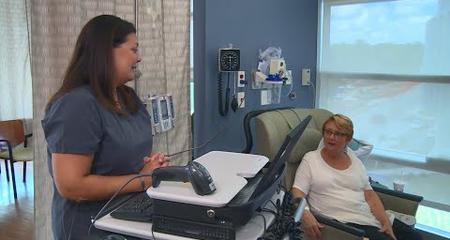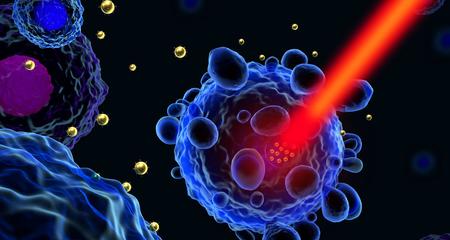Diagnosing lung cancer involves determining what type of cancer it is, which requires a biopsy, while staging involves identifying how advanced the cancer is.
A letter system also helps describe the extent of the cancer.
- T describes the primary tumor and is based on the size, location and extent of the tumor;
- N describes the number and location of lymph nodes involved; and
- M describes whether the cancer has spread to other areas of the body (metastasis)
Once lung cancer has been diagnosed, staging the cancer is critical in determining the best treatment approach.
In each case, our thoracic cancer team members work together to determine the treatment option that gives the patient the most benefit with the least risk. We follow established guidelines on how best to treat various stages of lung cancer, offer clinical trial participation where possible, and apply new technology and advanced treatment where necessary for the best possible outcome.
Stages of Lung Cancer
Following are general descriptions of the basic stages of lung cancer and standard treatments:
- Stage I: Early cancer confined to one lung without lymph node spread is treated with surgery alone. For certain high risk cancers, chemotherapy is given after surgery. Patients not healthy enough for standard surgery, are treated with limited surgery (Video-Assisted Thoracic Surgery or robotic surgery) or curative radiation.
- Stage II: Also an early stage cancer, with limited regional spread (usually within the same lung) that is best treated with surgery, possibly followed by chemotherapy and/or radiation therapy. Patients who are not healthy enough for surgery are treated with chemotherapy, radiation therapy or both.
- Stage III: A more advanced cancer (larger tumor, more extensive disease, lymph node involvement) that is generally treated with chemotherapy and radiation therapy, and surgery when possible based on the extent of the tumor and the health of the patient. Surgery can also be done prior to chemotherapy and radiation.
- Stage IV: Advanced cancer that has spread beyond the lungs or chest and is generally treated with chemotherapy or supportive care. Radiation and possibly other procedures are frequently used to control symptoms.
Tests to Stage Lung Cancer
A biopsy is a way of removing cells or tissue for examination to determine if cancer is present. A lung biopsy can be performed one of several ways:
- Bronchoscopy
- Super Dimension® Bronchoscopy
- CT Guided Needle Biopsy
- Video-Assisted Thoracoscopic Surgery (VATS)
- Endobronchial Ultrasound (EBUS)
- Endoscopic Esophageal Ultrasound (EUS)
Below are also several tests that can be performed to determine how advanced the cancer is:
- CT (Computed Tomography) Scan: This imaging test plays several roles in the diagnosis and treatment of lung cancer. It is often the first test that identifies a suspicious mass, and it can be used to guide needle biopsies, which are an important way to stage lung cancer. During a needle biopsy, the CT imaging helps the doctor guide the needle. With CT fluoroscopy (continuous X-ray imaging), doctors can watch the needle as it goes into the abnormal area and see exactly where the needle is at all times. That allows doctors to biopsy smaller, more difficult lesions, and it can shorten the procedure, which can reduce complications.
- PET/CT (Positron Emission Tomography/Computed Tomography) Scan: PET nuclear medicine technology has improved the accuracy of staging lung cancers over the past several years. For a PET scan, a tiny amount of a radioactive substance (tracer) is given to the patient, and the radiation emitted is measured. The tracer attaches to or is absorbed by the tissues in the body, and cancer cells absorb a large amount of the tracer. During the test, a special camera creates a picture of areas of radioactivity in the body. A PET/CT exam combines the two imaging methods. The PET scanner shows metabolism and function of cells, while the CT scanner shows detailed anatomy. Using computers, PET and CT scans are fused to produce a single scan. The radioactive tracer exits does not remain in the body: it exits through he urine.
PET/CT scans are especially useful in detecting whether cancer has spread to the lymph nodes, and can reveal whether the cancer has spread to the liver, bones, adrenal glands, or some other organs.
- MRI of Brain: If we suspect the lung cancer may spread to the brain, we may perform an MRI of the brain to make sure there is no metastasis there. MRI scans do not use radiation.
- Bone Scan: A bone scan is the most sensitive way of determining if lung cancer has spread to the bones. It’s another nuclear medicine test generally used only if other tests haven’t been clear on the spread to the bones. With a bone scan, a small amount of low-level radioactive material is injected intravenously, and travels through the bloodstream.
For more information on staging lung cancer, visit the American Cancer Society’s website.
Lymph Node Biopsies
Lymph nodes are important in establishing the final stage of the cancer. They are often biopsied at the same time as the mass or suspicious lesion. In staging, the N descriptor indicates if any lymph nodes are suspicious or involved.
As with the cancer itself, earlier stage lymph node involvement means a patient is a better candidate for surgical removal.
More advanced lymph node disease is better treated with radiation and chemotherapy or radiation alone in patients who cannot tolerate surgery. Palliative chemotherapy alone may also be appropriate.
Keep in mind that staging is very detailed and the prognosis for any stage of cancer can vary widely depending on the individual patient’s disease. Also, the lung cancer staging system changed slightly in early 2010, so some information you may find online may not be accurate. It’s best to consult with your doctor or care team about any staging questions.
Virtual Visits Are Available
Safe and convenient virtual visits by video let you get the care you need via a mobile device, tablet or computer wherever you are. We’ll gather your medical records for you and get our experts’ input so we can offer treatment options without an in-person visit. To schedule a virtual visit, call 1-866-680-0505.
More to Explore





